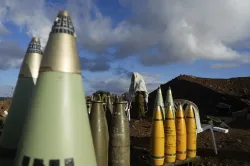Iran's missile capability: Strategies Israel uses to counter threat | Full comparison
Although the exact numbers for each type of missile are unknown. But US Air Force General Kenneth McKenzie told Congress in 2023 that Iran had “over 3,000” ballistic missiles. Here's a detailed report.

Iran fired a salvo of ballistic missiles at Israel on Tuesday in retaliation for Israel's campaign against Tehran's Hezbollah allies in Lebanon, drawing on an array of weapons that has long worried the West. The attack came five months after a strike in April that was the first-ever direct Iranian strike on Israel. Ballistic missiles are an important part of the arsenal at Tehran's disposal. According to the US Office of the Director of National Intelligence, Iran is armed with the largest number of ballistic missiles in the region.
Here are some detailsAccording to a 2021 report from the Missile Threat Project at the Center for Strategic and International Studies (CSIS), Tehran possesses thousands of ballistic and cruise missiles with varying ranges. While exact figures for each missile type remain unclear, US Air Force General Kenneth McKenzie testified before Congress in 2023 that Iran has "over 3,000" ballistic missiles, as noted in a recent report from the Iran Watch website, part of the Wisconsin Project on Nuclear Arms Control.
Ballistic missiles are designed to travel outside or near the edge of Earth’s atmosphere before the warhead separates from the rocket and descends back through the atmosphere toward its target.
Iranian missiles that could reach IsraelThe semi-official Iranian news outlet ISNA published a graphic in April showing nine Iranian missiles it said could reach Israel. These included the 'Sejil', capable of flying at more than 17,000 km per hour and with a range of 2,500 km, the 'Kheibar' with a range of 2,000 km, and the 'Haj Qasem', which has a range of 1,400 km, ISNA said.
The Arms Control Association, a Washington-based non-governmental organization, says Iran's ballistic missiles include 'Shahab-1', with an estimated range of 300 km; the 'Zolfaghar', with 700 km; 'Shahab-3', with 800-1,000 km; 'Emad-1', a missile under development with a range up to 2,000 km and 'Sejil', under development, with 1,500-2,500 km.
Iran has solid- and liquid-fueled missilesFabian Hinz, a Berlin-based expert on Iran’s missile arsenal with the International Institute for Strategic Studies, said that based on the locations of videos of launches posted on social media and the ranges to Israel, he assessed that Iran fired a combination of solid- and liquid-fueled missiles. The former category of missile, which is more advanced, is fired from angled mobile launchers and the latter from vertical launchers, he said.
He said three solid-propellent missiles fired on Tuesday could be the 'Haj Qasem', 'Kheibar Shekan' and 'Fattah 1'. Liquid propellant missiles reported as being launched from Isfahan might potentially be the 'Emad', 'Badr' and 'Khorramshahr', he said.
Iran is developing new missilesAccording to a 2023 report by Behnam Ben Taleblu, a Senior Fellow at the US-based Foundation for Defence of Democracies, Iran continues to develop underground missile depots complete with transport and firing systems, and subterranean missile production and storage centres. In June 2020, Iran fired its first-ever ballistic missile from underground, it said. "Years of reverse-engineering missiles and producing various missile classes have also taught Iran about stretching airframes and building them with lighter composite materials to increase missile range," the report said.
In June 2023, Iran presented what officials described as its first domestically made hypersonic ballistic missile, the official IRNA news agency reported. Hypersonic missiles can fly at least five times faster than the speed of sound and on a complex trajectory, which makes them difficult to intercept.
The Arms Control Association says Iran's missile programme is largely based on North Korean and Russian designs and has benefited from Chinese assistance.
Cruise MissilesIran also has cruise missiles such as Kh-55, an air-launched nuclear-capable weapon with a range up to 3,000 km, and the advanced anti-ship missile the Khalid Farzh, with about 300 km, capable of carrying a 1,000-kg (1.1-ton) warhead.
Israel capabilitiesIsrael employs a variety of systems to intercept threats, ranging from ballistic missiles that exit the atmosphere to low-flying cruise missiles and rockets. While much focus has been on the highly effective Iron Dome, designed to counter incoming rockets and artillery, it represents just the first layer of Israel's missile defence. According to the country's Missile Defense Organization (IMDO), it would not have been deployed against the ballistic missiles launched on Tuesday night, CNN reported.
The next level in Israel's missile defense system is David's Sling, which is specifically designed to protect against short- and medium-range threats, as outlined by the IMDO.
The Arrow 2 boasts a range of 56 miles and can reach altitudes of up to 32 miles, as noted by the Missile Defense Advocacy Alliance. They describe the Arrow 2 as an enhanced version of the US Patriot missile defences that Israel previously utilized, CNN reported. In contrast, the Arrow 3 employs hit-to-kill technology to intercept incoming ballistic missiles in space, targeting them before they reenter the atmosphere and head toward their destinations.
(With inputs from agency